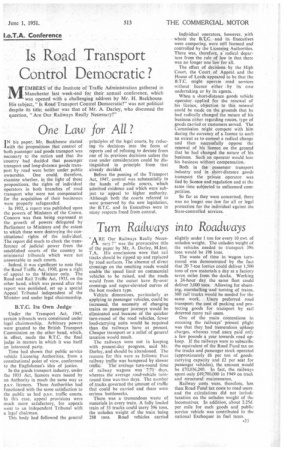Turn Railways into Roadways "A RE Our Railways Really Necessary ?"
Page 59

If you've noticed an error in this article please click here to report it so we can fix it.
was the provocative title of the paper by Mr. A. Darley,
T.A. His conclusions were that rail tricks should be ripped up and replaced by road surfaces. The absence of direct crossings on the resulting roads would enable the speed limit on commercial vehicles to be raised, and the roads would from the outset have fly-over crossings and super-elevated curves of the best modern type.
Vehicle dimensions, particularly, as applying to passenger vehicles, could be increased, the necessity of changing trains on passenger journeys would be eliminated and because of the quicker turn-round of the road vehicles, fewer load-carrying units would he required than the railways have at present. Cheaper transport or a relief of general taxation would result.
The railways were not in keeping with present-day progress, said Mr. Darley, and should be abandoned. The reasons for this were as follows: Fast railway traffic was hampered by slower traffic. 'The' average turn-round time of railway wagons was 711 days, whereas the average road-vehicle turnround time wasawo days. The number of tracks governed the amount of traffic that could be carried and there were serious bottlenecks.
There was a tremendous waste of materials in every train. A fully loaded train of 33 trucks could carry 396 tons, the unladen weight of the train being 288 tons, Road vehicles carried slightly under 1 ton for every 10,c-wt. of unladen weight. The unladen weight of the vehicles needed to transport 396 tons would be 198 tons.
The waste of time in wagon turnround was demonstrated by the fact that 20 7-ton lorries could deliver 1,500 tons of raw materials a day at a factory seven miles from the docks. Working a 24-hour day the same fleet could deliver 3,000 'tons. Allowing for shunting; marshalling 'and turning of trains, 300 rail trucks would be needed for the same work. Users preferred road transport; the cost of packing and protecting goods for transport by rail deterred many rail users.
One of the main contentions in excusing the railways' present plight was that they had tremendous upkeep charges, whereas road users paid only a few pounds a year towards road upkeep. If the railways were to subscribe the equivalent of the Road Fund tax on the trucks and passenger stock operated (approximately £6 per ton of goodscarrying capacity and £2 per seat for passenger vehicles), the amount. would be £70,036,240. In fact, the railways spent only £49,700,000 in 1949 on track
and structural maintenance, .
Railway costs were, therefore, less than Road Fund tax costs to road users. and the calculations did not include taxation on the unladen weight of the locomotives, In addition, about 2.25d. per mile for each goods and public service vehicle was 'contributed to the national Exchequer in fuel taxes.




























































































